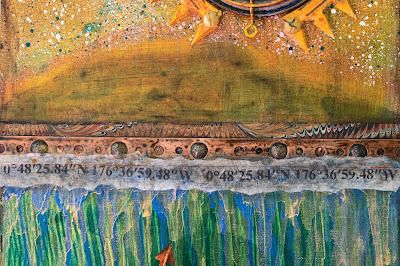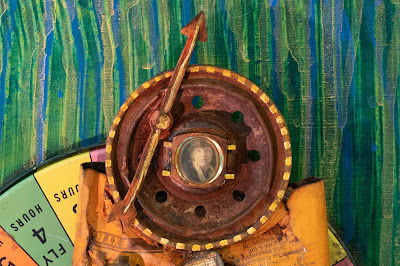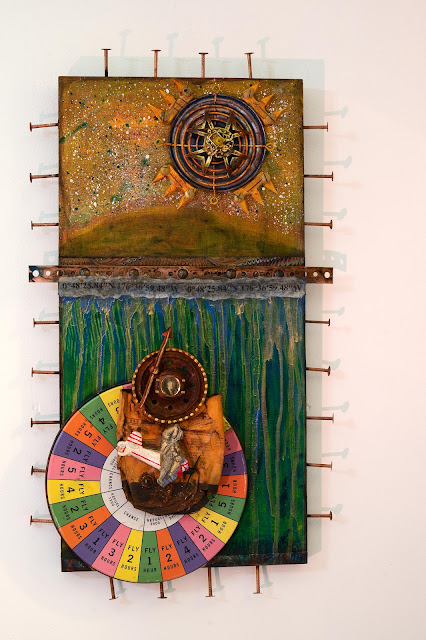This is the fourth project that came about as a result of taking the Michael deMeng on line workshop, Peculiar Portraits of Improbable People.
As I was looking through my file of faces to find something peculiar, I came across this artist rendering of a 1930's aviatrix. It immediately got me thinking about a woman I have read about, Amelia Earhart.
Normally for me the story comes as I am building my piece and does not hang on a factual person or event. Not so here, the story was clear from the beginning and off I went to search my stash for aviation appropriate finds.
Please note: the historical information about Amelia Earhart below is from the official Internet site for her.
Earhart began flying in 1921 and by 1937 she was world famous. For her fortieth birthday, she decided to attempt to be the first woman to fly around the world.
From the website: "On June 1st, Earhart and her navigator, Fred Noonan, departed from Miami and began the 29,000-mile journey. By June 29th, when they landed in Lae, New Guinea, all but 7,000 miles had been completed. Frequently inaccurate maps had made navigation difficult for Noonan, and their next hop—to Howland Island—was by far the most challenging. Located 2,556 miles from Lae in the mid-Pacific, Howland Island is a mile and a half long and a half-mile wide.
Every unessential item was removed from the plane to make room for additional fuel, which gave Earhart approximately 274 extra miles. The U.S. Coast Guard cutter ITASCA, their radio contact, was stationed just offshore of Howland Island. Two other U.S. ships, ordered to burn every light on board, were positioned along the flight route as markers. 'Howland is such a small spot in the Pacific that every aid to locating it must be available,' Earhart emphasized.
On July 2nd, At 10 a.m. local time, zero Greenwich time, the pair took off.
Despite ideal weather reports, they flew into overcast skies and intermittent rain showers. This made Noonan’s favored method of tracking, celestial navigation, difficult. As dawn neared, Earhart called the ITASCA, reporting 'cloudy weather, cloudy.'
In later transmissions, Earhart asked the ITASCA to take bearings on her. The ITASCA sent her a steady stream of transmissions, but she could not hear them. Her radio transmissions, irregular through most of the flight, were faint or interrupted with static. At 7:42 a.m., the Itasca picked up the message, 'We must be on you, but we cannot see you. Fuel is running low. Been unable to reach you by radio. We are flying at 1,000 feet.' The ship tried to reply, but the plane seemed not to hear. At 8:45 a.m., Earhart reported, 'We are running north and south.' Nothing further was heard from her."
Thus we have, We Are Running North and South. It is 22"H X 12"W X 4"D. It consists of a 20"H X 10"W Cradled Board, Metal Can Lid, Can, Metal Wheel, Toy Airplane, Watch Case, Clock Hand, Metal Jar Lid, Metal Grill, Jewelry, Metal Pieces (4), Copper Nails (26), Copper Banding, Images, Collage and Paint.










No comments:
Post a Comment